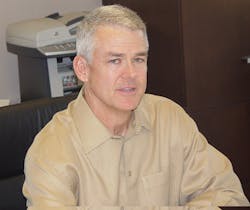Outpacing the Economic Forecasts: Benno Jurgemeyer, Harry Schneider, Graham Hood & Pat DeVitto's Expectations
Sunstate’s Jurgemeyer says he is seeing commercial buildings, abandoned during the recession, picked up by new owners and under development again.
RER: How was 2012 for Sunstate in general terms?
Jurgemeyer: Our recovery started the summer of 2011 and the positive trends continued throughout 2012. We have achieved strong double-digit revenue growth — north of
20 percent — for 2012 and, despite the challenging rate environment, we are developing some respectable margins as well.
What do you expect for 2013?
We are very optimistic about 2013 and expect similar growth to what we achieved in 2012. Our optimism for the most part is based on the opportunities we are seeing in the market place, in both the construction and non-construction business segments. We are seeing a lot of new construction breaking ground and more of these projects are coming from the private sector. We are also seeing evidence that the residential market is turning the corner, a good sign that the general economy is making progress. We have been outpacing the economic forecasts for two years, which is consistent with the theory that rental is increasing its share.
What are your customers telling you? Are they optimistic or pessimistic?
There is still a mix of feedback in the market place. Margins are still very tight for most contractors. So even if there is more work, it is still a battle for many. But there is also an undercurrent of optimism in the private sector. We see home builders buying dirt and preparing for an upswing in demand and pricing. We are seeing commercial buildings that were left half completed during the recession picked up by new owners and under development again.
What kind of projects look likely to happen in your areas?
Part of the reason for our optimism is the greater variety of projects we are anticipating in 2013. It is developing into a much better mix. The projects include solar plants, baseball stadiums, auto malls, distribution centers, more hospitals, apartments, etc. The new projects are in addition to many large projects already started in 2011-12 that will still run well into or through 2013.
How do you see various market segments for 2013, i.e., industrial, energy, nonresidential construction, residential, roads, bridges, schools, hospitals?
The answers vary market to market. But in general we see continuing opportunity in the energy sectors with oil and gas, solar and wind. We also see the industrial or non-construction sectors as some of our biggest areas of opportunity. In some markets the infrastructure sector is likely to slow down a bit given the lack of state and federal funding. But other sectors will be picking up or continuing; including retail, schools and healthcare.
Will you plan to add to your inventory in 2013?
We added a lot of fleet in 2012, and expect to add at least that much again in 2013.
Anything you can share about strategies you have planned for 2013?
Most of the capital we put to work will be needed to support the demand in our existing footprint, but we will start to expand geographically again in the near future. We are constantly investing in and improving our processes and systems. This is the backbone of the great customer service we consistently provide, and critical for increasing our efficiencies and margins at the same time.
What potential concerns do you have?
We believe the economy will continue its slow but steady recovery, and that the next four to five years are likely to provide great opportunity for the equipment rental industry. The increasing cost of equipment will be a longer term challenge for rental industry economics (longer because it will take years to increase the average cost of the fleet). At the same time it will also make it more challenging for customers to justify the investment in the higher cost machines; which should translate to greater reliance on the rental option.
Anything else you’d like to share or add?
Rental rates continue to be a challenge for the industry, but progress is being made. Most importantly there is better management information in the market place, which should help to drive better decisions by all the rental players. We not only need to recover some of the pricing lost during the recession, but we will need to compensate for the increase in fleet cost as the averages push higher in the coming years. rer
Equipment Purchases to Grow in 2013: Harry Schneider
Harry Schneider, president of Allied Financial Solutions, Florence, Ky., talks about why rental companies are likely to grow or replace fleet in 2013 and how finance programs can facilitate.
Schneider: We had a very good year. We expected a little slowdown closer to the election and that is what we saw. Since the election things have picked up considerably. Companies are going to have to get back to business in 2013. That means they are going to have to upgrade their fleet to make sure they are putting quality assets to work for their customers. We should see a nice increase in opportunities for providing funding to our customers in 2013.
What is the current environment like for rental companies looking to make equipment purchases? Are credit standards more stringent than ever or is there greater flexibility?
Our portfolio is a mixture of in-house funding and bank partnership financing. All of our partners are very comfortable with the rental industry. Our approval ratio is extremely strong. The major concern is still that the rental companies’ balance sheets have been hurt a bit by high depreciation on present assets and, in a lot of cases, lower profits. Some rental companies cannot borrow on the strength of their financial statements but still have an excellent credit rating. That is why we developed an application-only product up to $150,000. It has worked out pretty well over the past three years.
What are your customers telling you in terms of their expectations for the year ahead?
The answer to this question is two-fold. The customers who are calling us are doing well. They have seen their rental revenues increase and need additional equipment to meet their rental needs. But the customers who are not calling us are telling us a story too. They do not have any needs at this time. The unspoken story there might be that revenues are strong enough to support growth out of cash flow or revenues have not returned to a level that warrants additional inventory at this time. That said, a large percentage of our current customers who have spoken with us have told us that they have business booked for 2013 already and will be making purchases during the trade show season.
Do you expect rental companies in general will be purchasing more in the coming year than in the past year?
I am certain that there is a lot of aging equipment on the lots. Maintenance costs have to reach a point soon where the purchase of new equipment is mandatory. We will see some of that in 2013 and 2014. So, equipment purchases should pick up considerably starting in 2013.
What is your sense of the economy in general?
There are two types of economies. There is the economy that is reported on by the Feds every month. Then there is the economy that affects mom and pop. Although what happens in Washington causes us to have ulcers, it is our local economy that really matters to us. We play a major role in that local economy. Why are some areas doing so much better than others? Simply because the local governments have partnered with the local businesses to create a trust that promotes growth. More communities and states are moving to such cooperative measures. That is very encouraging.
What kinds of issues concern you most looking at the overall picture at things that could affect your business — gridlock in Washington, oil prices, European debt issues?
We have to ask ourselves again if what is happening in Washington is really any different than what happened last year or the year before. If there is one thing that will hurt a national economy or a business it is politics! Politicians are professional politicians. Their business is politics. And politics gets in the way of proper reasoning. Yes, the results of the negotiations in Washington could hurt my pocketbook. But, they cannot destroy my desire to grow my business and help other people grow theirs. rer
Uncertainty Should Help the Rental Industry: Graham Hood, CEO Neff Rental
Graham Hood says most of Neff’s customers are cautiously optimistic about 2013 and have planned work on the books.
Hood: 2012 was a good year for our company with broad-based revenue growth in all of our key customer segments and improvement in all of our key revenue metrics.
What do you expect for 2013?
Many of the key indicators that we look at are pointing to continued modest growth in most of our markets. Dodge is predicting 6-percent growth in overall construction, the ABI has been trending positively above 50 for several months and Global Insight is predicting continued growth performance for the rental industry, aided by the accelerated shift from equipment ownership to rental. These factors along with the ongoing strength of the energy sector and a slowly improving general economy indicate that we should see continued improvement in our business in 2013.
What are your customers telling you?
The feedback varies, but most of our customers indicate that things are slowly improving and most are cautiously optimistic about 2013 with planned work on the books. We are not seeing any significant projects being delayed.
What kind of projects look likely to happen in your areas?
We are seeing more commercial projects starting to materialize in many markets, which is encouraging.
How do you see various market segments for 2013, i.e., industrial, energy, nonresidential construction, residential, roads, bridges, schools, hospitals?
I am expecting to see more of what we saw in 2012 with most of the segments we deal with showing relative improvement and modest growth. The oil and gas sector should remain strong.
Will you plan to add to your inventory in 2013? Anything you can share about how much you want to spend or comparison with 2012?
We had an above-average capex spend in 2012 with three new branches, replacement capex to continue to manage fleet age and some fleet growth in many of our existing branches. 2013 is projected as a normal capex year for replacements along with conservative fleet growth. That could change based on increased customer demand as we move through the year.
Anything you can share about strategies you have planned for 2013?
We continue to focus primarily on our existing network of branches, managing the fleet to meet customer demand, increase operating leverage and margins; as well as continued improvement of our key metrics of rate and utilization. We have a couple of new branch openings planned, which will add synergies to and complement our existing footprint.
What potential concerns do you have — gridlock in D.C., European debt crisis, the cost of equipment, price of oil or other resources?
Obviously you have mentioned several other potential landmines out there for the economy, but any uncertainty should help the rental industry as customers contemplate the rental-versus-ownership decision. Equipment costs are increasing with Tier 4 technology and the industry will have some time to absorb those costs, but in order to maintain and increase industry returns, we all have to continue to be diligent in managing rental rates.
Anything else you’d like to add?
It is key that the companies within the industry remain disciplined in managing their fleet size and continue to focus on improving rates as a priority. rer
Improve the Infrastructure: Pat DeVitto, Cardinal Sales
Veteran manufacturers’ rep Pat DeVitto, whose Brooklyn, N.Y.-based Cardinal Sales celebrated 25 years in business in 2012, offers his regional perspective and why rental companies should keep their eyes on equipment lead times when purchasing.
DeVitto: Cardinal’s 2012 business was up 11 percent over 2011. I believe most of our customers were up over last year.
What do you expect for 2013, for your business and for your rental customers?
I see us all having a better year than 2012. A lot may depend on some government money for infrastructure.
What was most surprising to you in the business in 2012?
The consistency of the ordering during the year. Outside of a slow July — which was a three-week month with the 4th falling on a Wednesday — every month was steady. We did have a major storm (Sandy), which pushed sales to abnormal levels in November.
Are their particular products that you expect will be important in 2013, items that you think will be important to your rental customers? And why?
In our area, damage from Sandy is estimated at more than $60 billion dollars. That’s major money. Clean up will require equipment such as hot-water pressure washers, light towers, skid steers with attachments like grapple buckets, hydraulic hammers and trash hoppers. Also generators for power, and blowers to dry waterlogged homes and heaters for the sites. Once the cleanup is done the rebuilding will use everything from aerial lifts to excavators.
What kinds of work do you expect to be important for your rental customers in 2013 — what kinds of projects?
Aside from the abovementioned storm-related work, natural gas drilling in Pennsylvania and some major bridge projects such the Tappan Zee Bridge in New York. Several casinos have been approved in New England and are waiting on sites.
What kinds of industries or customer segments do you think will be especially important for rental business in 2013?
General construction including infrastructure and plant updates.
Tell me about the region or territory where you do business — what will drive it economically in the year to come?
Our area — Maine to Virginia — is the oldest in the nation, which means older roads and bridges. Couple that with extreme weather and you have the need for constant infrastructure upgrades and restoration. Hopefully, New York State will join Pennsylvania and approve fracking for natural gas. This will bring thousands of construction jobs along with equipment to the area.
Any particular issues that concern you?
The one thing that will concern me is equipment lead times. Because of the recent economy many customers have been cautious in replacing or adding to their rental fleets. For the same reason, manufacturers are not stockpiling inventory. Customers delaying orders may find it hard to receive the equipment in time for the full season. rer
About the Author
Michael Roth
Editor
Michael Roth has covered the equipment rental industry full time for RER since 1989 and has served as the magazine’s editor in chief since 1994. He has nearly 30 years experience as a professional journalist. Roth has visited hundreds of rental centers and industry manufacturers, written hundreds of feature stories for RER and thousands of news stories for the magazine and its electronic newsletter RER Reports. Roth has interviewed leading executives for most of the industry’s largest rental companies and manufacturers as well as hundreds of smaller independent companies. He has visited with and reported on rental companies and manufacturers in Europe, Central America and Asia as well as Mexico, Canada and the United States. Roth was co-founder of RER Reports, the industry’s first weekly newsletter, which began as a fax newsletter in 1996, and later became an online newsletter. Roth has spoken at conventions sponsored by the American Rental Association, Associated Equipment Distributors, California Rental Association and other industry events and has spoken before industry groups in several countries. He lives and works in Los Angeles when he’s not traveling to cover industry events.




